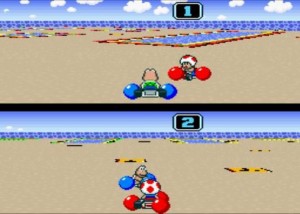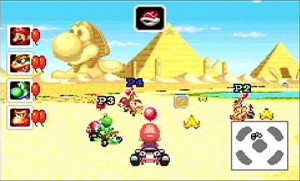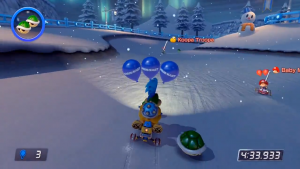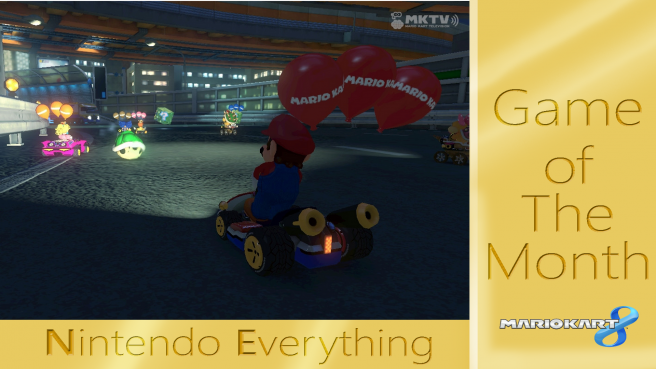[Feature] Did Mario Kart 8 ruin Battle Mode?
For all of the fresh and welcome adjustments Mario Kart 8 brought to the series, there was one mode that saw a massive set of changes much to the dismay of many: Battle Mode. Doing away with the iconic arena stages prevalent in previous entries, Mario Kart 8 opted instead to re-use existing tracks to create somewhat of a joust around the courses, an unwelcome change to many fans. Combine that with the initial lack of a mini-map, the implication for couch co-op with a twelve-player cap and the fact that the tracks were larger and more open than ever, many fans felt that Nintendo had missed the mark when it came to capturing what the Grand Prix’s little brother was all about. Battle Mode has undergone a number of changes over the eight entries in the franchise. We’ve seen the size of the arena grow from two to twelve, the addition of bikes and countless other tweaks to the original inclusion back in 1992, but is the shift in focus really to blame entirely on Mario Kart 8? What should Battle Mode in a modern day Mario Kart even look like anyway?
Super Mario Kart’s Battle Mode premise was simple: you and a friend on the couch trying to knock out the other’s three balloons by collecting and deploying items found on the map. Arenas were symmetrical, cozy and open enough so you were always aware of what your opponent was up to at any given moment. It’s easy to forget the small player cap the original entry had and Super Mario Kart compensated for that with great visibility of the entire course, so you always had an idea of where your opponent was at any given moment. The premise was simple and the execution was great which made it a couch multiplayer hit.

As the series made its debut in 3D, Mario Kart 64‘s Battle Mode formula had to change to account for that. The differing terrains were a big change from the original and that would have implications on visibility, one of Super Mario Kart‘s biggest strengths. Additionally, the bump to four players created a new issue – what do you do with players that bow out of the competition early? The former had an easy fix: keep arenas small and chuck in a mini-map to help players find each other (because of course, nobody ever screen cheated). If you were one of the unfortunate players to get eliminated prior to the round’s end, you were transformed into a bomb kart and were free to wreak havoc and blow up players still in the running by colliding with them. Regarded by many as the best Battle Mode entry, it’s clear that a great deal of care was taken to bring the mode over to true 3D, ensuring the formula stayed strong. Also, Block Fort rules.

Mario Kart Super Circuit was very reminiscent of Super Mario Kart in a lot of ways, which makes sense when considering the relative hardware power of both the Super Nintendo and Game Boy Advance. The key difference between Super Mario Kart and Super Circuit was the entry point – it was a lot harder to get four people with consoles and link cables in one place compared to two to four players around one TV. Not a lot of innovation happened with this entry and mechanically it plays very similar to the original, though it does borrow some of the improvements from Mario Kart 64 such as the Bob-omb transformation for those who lose early. It’s hard to fault the Battle Mode of Super Circuit as its shortcomings are very much a product of the hardware it was produced for, but as the series began to start experimenting and taking a few more risks, so did Battle Mode and it’s safe to say here’s where opinions started to split.

The addition of a second racer on every kart added an interesting dynamic to Battle Mode in Mario Kart Double Dash. The co-op aspect, which saw two human-controlled players on the same kart, opened up a new way to steal balloons from players and a whole new set of things to think about when racing around the arenas. You no longer needed to boost through a player to steal balloons. During any slide, the player on the rear of the kart had the chance to grab an opposing balloon on impact. Additionally, Double Dash was also the first time in the series where there were varying objectives. The classic Balloon Battle was still featured alongside Bom-omb blast which worked quite similarly, but with bom-ombs as the only items. The biggest shake-up came through Shine Thief, where the objective was to hold a single Shine for as long as possible. Double Dash made significant changes to the Mario Kart formula and was the first time for better or worse, Battle Mode really started to get away from the formula used up to that point.

The second handheld outing came in the form of Mario Kart DS and its wireless functionality helped negate a lot of the initial issues that were prevalent on the GBA. Shine Thief (now Shine Runners) made a return alongside Balloon Battle, but that wasn’t all. For the first time in the series, players were able to add CPU racers to Battle Mode which on paper seemed like a great way for people who didn’t have access to others to enjoy the mode. Mario Kart DS was remembered fondly because it did a lot of things differently and a lot of things right, from the series’ first online mode to the incredibly fresh mission mode. Adding CPUs to Battle Mode really didn’t have the same impact as either of those things, which perhaps was good enough motivation for the changes that came next.

Mario Kart Wii: Famous for raising the player count to twelve per race, adding bikes next to karts and TIMED BALLOON BATTLES!? With every map now that much larger due to the increased number of players, it was a clear a significant change had to be made to the Balloon Battle formula to avoid matches dragging on for an eternity. So how did the time limit affect things? Team-based battles were a lot more prevalent and it operated on a point based system. Losing all three balloons cost your team a point and you respawned right back into the action to ensure maps never felt empty. The only other mode to be featured in Mario Kart Wii was Coin Runners in which players would collect coins scattered on the map and hit other players to get them to drop theirs. Change was necessary when dealing with battles of that size and the changes to Battle Mode echoed a lot of the changes in Mario Kart Wii as a whole – everything got bigger. Interesting to note is that all of these changes made their way to Mario Kart 7, despite the player cap for that game being eight and that entry had no significant alterations outside of that.

Despite all the changes that had been made up to this point, no other iteration caused more anger among fans than Mario Kart 8‘s Battle Mode. The biggest and most controversial change was no doubt the doing away of battle arenas entirely, opting instead for ‘revamped’ versions of traditional courses which created a number of new issues (outside of the fact they were just courses that ignored the finish line). Courses were huge in Mario Kart 8 like in Wii, as they were accounting for the twelve player setting, which made conflicts a lot more infrequent than you’d like out of a Battle Mode. Combine this with the (initial) lack of a mini.map and you would often spend the majority of the timed based battle struggling to any sort of competition. The balloon system was once again reworked: every player starts with three points and three balloons, scoring a hit on an opponent awards you a point and getting hit costs you both a point and balloon. Balloons don’t respawn and additional ones can only be regained by stealing another player’s. An intimate Battle Mode setting was never going to work in a twelve player setting so much like in Mario Kart Wii, change made sense. Though some felt the jousting format was lazy and the execution was certainly not perfect at launch, it’d be difficult to fault Nintendo for trying to evolve the format as the series continued to change.

It’s undeniable that Mario Kart has evolved significantly from the two-player couch competition of yesteryear, and when you consider the fact that you’re never going to have twelve people playing on the one TV, the need for change starts to make sense… but to what is a different issue entirely. You can’t split a TV twelve ways, but do you have to? Does four player split-screen still work in a modern day setting? Regardless of how it turned out, Mario Kart 8‘s Battle Mode begs a very important question: what does Battle Mode look like in a modern day Mario Kart? The intention of the last couple of home iterations have been clear with the emphasis on the twelve player cap, but whether or not that’s the right move going forward is anybody’s guess. Mario Kart is constantly evolving and if Battle Mode is to remain relevant it needs to continually evolve with it. The execution may not have been perfect, but Nintendo’s willingness to experiment in Mario Kart 8 made sense as it’s a move to help ensure Battle Mode remains pertinent in the future, in whatever form it may take.
What do you want to see out of Battle Mode going forward? Would you want to see a return of four player split-screen arenas or something fresh for a new era? Do you even care about Battle Mode anymore? Let us know in the comments!
